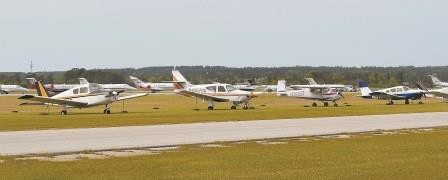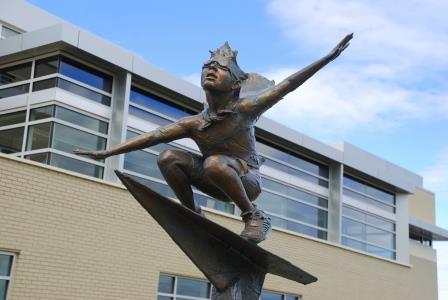Several years ago, at a ribbon cutting in Orangeburg, an industry representative told City Administrator John Yow that the city’s municipal airport was exactly what his company was looking for as it scouted locations.

During Masters Week, more than 50 flights will land and take off daily from the
Aiken Municipal Airport. (Photo/Dan Brown/Aiken Standard)
"I don’t know if we would have gotten that industry without the airport," Yow said. "And it’s not just for attracting industry; it helps us retain the businesses we have."
This is a familiar story told by city leaders and directors of municipal airports around South Carolina. A nearby general aviation airport helps attract new industry, allows easy access for corporate jets, lets existing companies quickly fly in necessary equipment and provides a convenient spot for law enforcement or news helicopters to land.
It’s also not unusual to see a university plane bring in a coach to check out a high school prospect. During the recent presidential primary season, candidates hopped to campaign events throughout the state via small jets landing at municipal airports.
"Research has shown that airports are economic multipliers," said Adam Williams, manager of airport policy for the Aircraft Owners and Pilots Association, a national nonprofit organization that advocates for general aviation. "For every dollar invested in an airport, the economic benefit is more than $2."
The benefit of municipal airports is two-fold. As the airport’s owner/operator, the city benefits from the businesses that are based at the airport. The city also benefits from the economic activity generated by companies in nearby industrial parks and other firms that are able to successfully operate because there is a nearby airport.
"When the town talks to a potential industry, one of the first things that comes up is, ‘Is there an airport?’" said Wendall Hall, director of the Cheraw Municipal Airport, where nearby companies including INA Bearing and Highland Industries make flights in and out a few times each week.
The City of Spartanburg Downtown Memorial Airport is the city’s largest owned asset, serving more than 100 local aircraft along with corporate jets representing many of Spartanburg’s largest companies.

Spartanburg's Group of 100 donated the statue of the young child taking flight on a paper plane for the grand reopening of the Spartanburg Downtown Memorial Airport in 2011 after extensive renovations. The Group's roughly 100 anonymous members donate $1,000 annually to fund beautification projects in the community. (Photo/City of Spartanburg Downtown Memorial Airport)
According to the city, the airport contributes $25 million to the local economy, with 190 aviation-related jobs and a payroll above $10 million.
Those numbers are likely to increase with the addition of Toray Industries, the world’s largest carbon fiber producer that is building a $1.4 billion plant in the nearby community of Moore. The Japanese company’s plant will initially create about 500 jobs, the largest initial economic investment in South Carolina, according to the SC Department of Commerce.
And it is not just the corporate jets taking off and landing, said Darwin Simpson, director of Spartanburg’s municipal airport. With Spartanburg Regional Healthcare System’s participation in the national organ donor program, surgeons and medical teams are flying in and out at all hours, he said.
"If you have to have a transplant, it’s not going by UPS," Simpson said. "It’s going on a private aircraft. We have all kinds of medical flights every day. All vital services that are essential happen in general aviation. It’s all about being able to get somewhere in a short period of time."
From the Spartanburg municipal airport, it’s a four-minute drive to downtown Spartanburg, while it is about a 35- or 40-minute commute to the commercial Greenville Spartanburg International Airport, he said.
The airport also has historic significance. It is one of the oldest airports in America and the first commercial airport in South Carolina. The airport opened in 1927 with aviator Charles Lindbergh participating in the grand opening. Amelia Earhart also visited the airport, and Army Air Corps pilots trained there during World War II.
The Orangeburg Municipal Airport and its 5,700-foot runway are used extensively for economic development, along with serving local business people such as attorneys and other professionals.
In addition, Yow said the industrial park adjacent to the airport is almost full, although the airport recently identified 90 acres it can offer for business and industrial development on the airport’s grounds. "We’re actively working with the economic development office to market the airport property," Yow said.
He also said business is just one of the selling points of a municipal airport.
"Remember it’s not just economic development. For a lot of people, it’s part of their transportation plan," he said. "You can get to the Bahamas in 80 minutes from Orangeburg."
